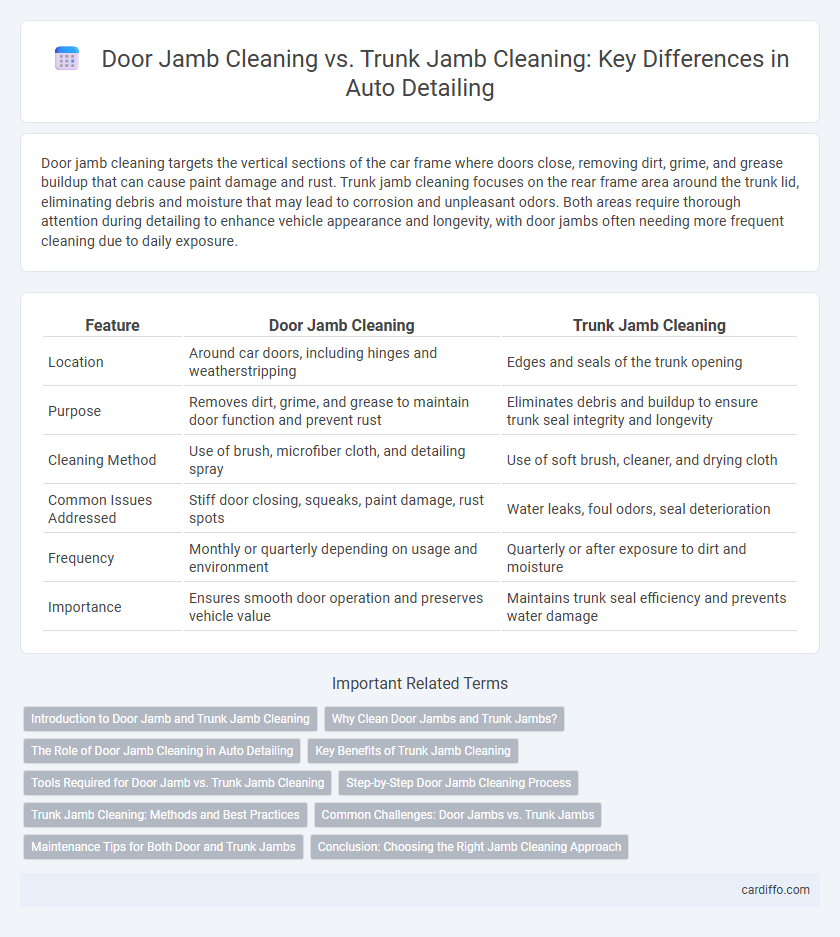Door jamb cleaning targets the vertical sections of the car frame where doors close, removing dirt, grime, and grease buildup that can cause paint damage and rust. Trunk jamb cleaning focuses on the rear frame area around the trunk lid, eliminating debris and moisture that may lead to corrosion and unpleasant odors. Both areas require thorough attention during detailing to enhance vehicle appearance and longevity, with door jambs often needing more frequent cleaning due to daily exposure.
Table of Comparison
| Feature | Door Jamb Cleaning | Trunk Jamb Cleaning |
|---|---|---|
| Location | Around car doors, including hinges and weatherstripping | Edges and seals of the trunk opening |
| Purpose | Removes dirt, grime, and grease to maintain door function and prevent rust | Eliminates debris and buildup to ensure trunk seal integrity and longevity |
| Cleaning Method | Use of brush, microfiber cloth, and detailing spray | Use of soft brush, cleaner, and drying cloth |
| Common Issues Addressed | Stiff door closing, squeaks, paint damage, rust spots | Water leaks, foul odors, seal deterioration |
| Frequency | Monthly or quarterly depending on usage and environment | Quarterly or after exposure to dirt and moisture |
| Importance | Ensures smooth door operation and preserves vehicle value | Maintains trunk seal efficiency and prevents water damage |
Introduction to Door Jamb and Trunk Jamb Cleaning
Door jamb cleaning involves thoroughly removing dirt, grease, and grime from the vertical frame where the car door seals, enhancing both appearance and preventing rust buildup. Trunk jamb cleaning targets the edges and hinges of the trunk area, ensuring smooth operation and maintaining the cleanliness of hard-to-reach spots that often accumulate debris. Both services are essential for comprehensive automotive detailing, preserving the vehicle's finish and protecting metal surfaces from corrosion.
Why Clean Door Jambs and Trunk Jambs?
Cleaning door jambs and trunk jambs removes accumulated dirt, grease, and road grime that can cause corrosion and damage over time. Regular maintenance preserves the paint finish, preventing rust and ensuring a showroom-quality appearance. Dirt buildup in these hidden areas also compromises seals, leading to potential water leaks and interior damage.
The Role of Door Jamb Cleaning in Auto Detailing
Door jamb cleaning plays a crucial role in auto detailing by preventing the buildup of dirt, grime, and moisture that can lead to rust and paint damage around the vehicle's entry points. Unlike trunk jamb cleaning, which primarily targets the rear compartment area, door jamb cleaning ensures all door edges, hinges, and seals remain spotless and well-maintained, enhancing both the car's appearance and longevity. Proper attention to door jambs contributes to a thorough detailing process that protects critical components and improves overall vehicle hygiene.
Key Benefits of Trunk Jamb Cleaning
Trunk jamb cleaning removes accumulated dirt, grease, and debris, preventing rust and corrosion that can compromise the vehicle's structural integrity. It enhances the overall appearance by restoring a clean, polished look, which is often overlooked compared to door jambs. Regular trunk jamb maintenance also improves the sealing effectiveness, reducing water leaks and protecting the interior from moisture damage.
Tools Required for Door Jamb vs. Trunk Jamb Cleaning
Door jamb cleaning requires precision tools such as microfiber towels, detailing brushes, and all-purpose cleaners to effectively remove dirt and grime from tight seams and hinges. Trunk jamb cleaning often necessitates larger brushes and stronger degreasers to tackle accumulated debris and grease in wider, less accessible areas. Both processes benefit from the use of soft bristle brushes to avoid paint scratches while ensuring thorough cleaning.
Step-by-Step Door Jamb Cleaning Process
Door jamb cleaning begins by removing loose dirt and debris using a soft brush or vacuum to prevent surface scratches. Next, apply an automotive all-purpose cleaner with a microfiber cloth, scrubbing gently to break down grime and grease accumulated from daily use. Finish the process by rinsing with clean water, drying thoroughly, and applying a protective dressing to maintain the door jamb's finish and prevent future buildup.
Trunk Jamb Cleaning: Methods and Best Practices
Trunk jamb cleaning requires thorough attention to remove dirt, grease, and road grime accumulations effectively, using gentle brushes, microfiber towels, and automotive detailing sprays to protect paint surfaces. Employing specialized brushes helps reach tight corners and crevices, while consistent use of pH-balanced cleaners prevents damage to rubber seals and prevents premature wear. Regular maintenance of trunk jambs enhances vehicle aesthetics and prevents corrosion, ensuring longevity and a pristine appearance.
Common Challenges: Door Jambs vs. Trunk Jambs
Door jamb cleaning often involves navigating tight hinges and weather stripping buildup, making it challenging to remove dirt and grease from these narrow, hard-to-reach spaces. Trunk jamb cleaning presents difficulties due to accumulated debris, rust, and moisture traps that can cause corrosion over time. Both areas require precise tools and techniques to thoroughly clean without damaging seals or paint.
Maintenance Tips for Both Door and Trunk Jambs
Regularly cleaning door jambs and trunk jambs prevents dirt buildup that can cause paint damage and rust over time. Use a soft brush with mild soap and water to gently scrub these hard-to-reach areas, followed by drying with a microfiber cloth to avoid moisture retention. Applying a protective wax or sealant to both door and trunk jambs enhances durability and maintains the vehicle's aesthetic appeal.
Conclusion: Choosing the Right Jamb Cleaning Approach
Door jamb cleaning targets the vertical frame around vehicle doors, removing dirt, grease, and debris that accumulate with frequent use, while trunk jamb cleaning focuses on the horizontal and vertical sections of the trunk opening, addressing grime from road exposure and cargo handling. Selecting the right jamb cleaning approach depends on the vehicle's usage patterns and the areas most exposed to contaminants; combining both methods ensures comprehensive maintenance for overall vehicle cleanliness and preservation. Prioritizing specific jamb cleaning based on assessment optimizes detailing efficiency and enhances the longevity of seals and trim.
Door Jamb Cleaning vs Trunk Jamb Cleaning Infographic

 cardiffo.com
cardiffo.com